

„Hojo undo” translates as supplementary exercises, however this translation greatly under estimates the importance of this training to the traditional Goju Ryu Karate system. Hojo Undo is more than supplementary exercises, but as power, strength, condition, reflex and coordination training, it is linked directly to all kata and is vital for any traditional Goju Ryu Karate practitioner, as it links kata to applications.
To make kata techniques applicable, the karate-ka always has to condition the appropriate area of the body in order to be able to perform a particular technique properly. For example, if someone were to perform a nukite (spear hand) strike without the appropriate training, he would most likely damage his own hand. Hojo undo is the path to obtaining the appropriate conditioning.
This article will focus on the basic essential hojo undo equipment, namely the chi-shi, the nigiri game, the sa-shi, the kongo ken, the tetsu geta, and the makiwara, giving a brief description of each apparatus while discussing its importance for the development of the body, and where relevant, explaining the importance to Goju Ryu kata. Only the most basic exercises for each apparatus will be discussed.
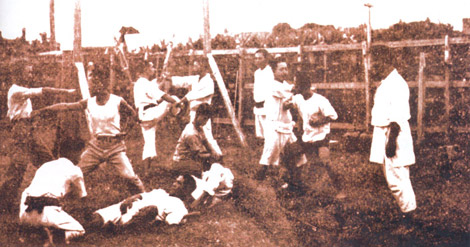
Chojun Miyagi, the Founder of Goju Ryu (extreme right) watches as his students practise hojo undo. It is interesting to note that the third person from the right is Kenwa Mabuni, the Founder of Shito Ryu karate.
Photo courtesy of Morio Higaonna Sensei.
It is up to the individual karate-ka to practice the exercises relevant to him so as to concentrate on his weaknesses. For example if the left hand is weaker than the right hand, twice the number of repetitions should be performed with the left hand. Also, as the applications discussed are only basic, the karate-ka is encouraged to develop his own variations of the basic applications so as to eliminate his particular weak points in kata. In saying this, however, the importance of the basic exercises must not be over looked.
The Chi-shi is a weighted stone at the end of a stick. There are two distinct types of chi-shi. One has a disk shaped stone (or concrete block) at the end of a stick no longer then the karate-ka’s arm, the other has the stone attached to a stick similar in length to a bo and much longer than the arm. In both cases the thickness of the stick is slightly less than the thickness of the wrist. Only the former type of chi-shi will be discussed here.
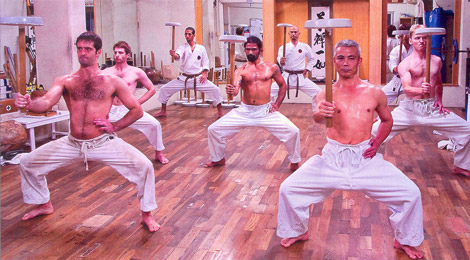
Training with chi-shi at the Higaonna Dojo,
Tsuboya, Okinawa, November 2009.
The Chi-shi’s primary purpose is tostrengthen the wrist, but if performed correctly, the lateral muscles and the forearms will also be strengthened significantly.
For the initial exercises the chi-shi should be gripped by one hand at the end of the stick opposite the stone (ifthe chi-shi is too heavy, it may be gripped closer to the stone). The karate-ka may then swing the chi-shi in four different ways: from side-to-side, front-to-back, in a vertical circle around the shoulder of the gripping hand, and in a horizontal circle around the entire body. In all four exercises the practitioner should drop into shiko datchi (sumo stance) while balancing the chi-shi in the middle position. In the middle position, the arm of the hand gripping the chi-shi is extended in front of the body with the hand directly beneath the stone, balancing its weight, with the other hand on the hip. The gripping hand should squeeze the stick or handle strongly for a moment, like the kime (focus) at the end of a punch.The lateral muscles should pull down tightly, keeping the shoulder from lifting.
When moving from the middle position, rise from shiko datchi, and slightly relax the grip as the chi-shi is swung, then return to the middle position, dropping into shiko datchi and squeezing with strong kime.
These exercises, when balancing the chi-shi in the middle position, work the stabilizing muscles in your arm, so your wrist will be strong and not buckle under the force of a punch when applying any punch from a kata. If the lateral muscles are used correctly and kept tight, keeping the shoulder down at the moment of kime, this will build the relationship rooting the muscles to the floor, and develop stronger, more grounded techniques and a better Sanchin.
In the next set of exercises the chi-shi is gripped with both hands, at a comfortable interval one above the other as far from the stone as possible. Remaining in shiko datchi, the handle should be squeezed strongly both hands as the chi-shi is extended: in front ofthe body with the stone at the in front of the body with the stone at the bottom, and to the rear between the legs.
These exercises will help develop grappling techniques and body strength, mainly in the wrists.
In the final basic chi-shi exercise the karate-ka thrusts with the chi-shi. The chi-shi is held with both hands, one close to the stone the other at the opposite end of the handle. The karate-ka thrusts with the chi-shi from shiko datchi in a motion similar to jabbing with a spear or bo, twisting the chi-shi with the wrists.
This exercise will develop a stronger punch while helping to develop the corkscrew action of a punch. All the basic chi-shiexercises utilize shiko datchi to develop leg strength.
Nigiri game or gripping jars are large ceramic pots with an opening shghtly larger than the size of your palm. They may be left empty or fоlled with water, sand, or other material as your grip strengthens.
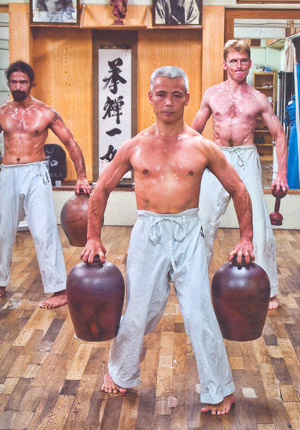
Training with nigiri game.
Note the feet gripping the floor.
Photo CFA staff.
The nigiri game’s primary purpose is to develop asuri-ashi (sliding feet) while strengthening your grip. The karate-ka may practice any form of asuri-ashi while training with the jars. The most important forms of asuri-ashi to be practiced regularly are the sanchin step with the tanden open (kaishugata or relaxed), the sanchin step with the tanden closed (heishugata or tight), and stepping in shiko datchi (as with Seiyunchin Kata).
The jars should be gripped tightly, squeezing strongly while lifting them, concentrating on the little finger and thumb. The grip should be in the form of an eagle claw, gripping with the four finger tips and the first knuckle of the thumb (which should be bent like a fish hook). The hands should twist to the inside, the same as the twist of a punch, so the little finger pushes to the front and the thumb to the back. The lateral muscles should always be kept tight with the shoulders down, and the shoulder blades pinching slightly together.
Nigiri game are essential for developing a strong grip, a tight fist, and finger strength for the nukite strike. Without extensive nigiri game practice, you will find it nearly impossible to apply Goju Ryu kata techniques in a real life situation, as those techniques rely heavily on the ability to use a strong grip, grabbing and pulling the opponent. Without the finger strength from nigiri game, you will have great difficulty developing a proper nukite strike. (Note: In order to develop a useful nukite, other conditioning is required, using for example, the to,bamboo bundle, or sand).
In order to perform a good Sanchin Kata, you must have a tight grip, strong lateral muscles, and be able to close the buttocks and keep the tanden tightly rolled. Nigiri game practice is the key to obtaining this, and it is recommended that you perform nigiri game with a closed tanden several times before daily Sanchin Kata practice.
Sa-shi or padlocks (usually referred to as ishi sa-shi or tetsu sa-shi, stone or metal padlocks) are just that, large padlocks that can be used as hand weights. They are more useful than dumbbells as the shape permits a wider variety of exercises.
The first exercises are stationary gripping techniques. In these techniques the karate-ka gnps the sashi by the narrow bar (opposite the body of the padlock) through the hole so the heaviest part is furthest from the center of the grip. This position helps to strengthen the wrist when the wrist is cocked.
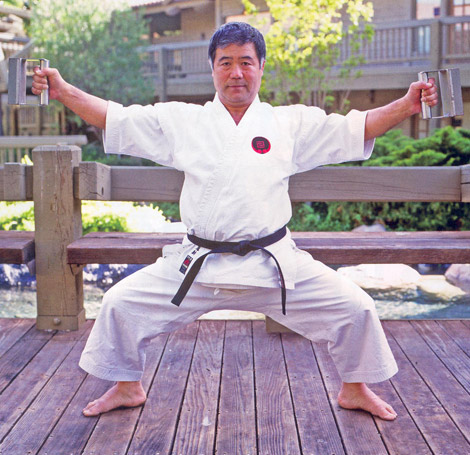
Higaonna Sensei training with steel ishi sashi, Thousand Oaks, California.
Photo courtesy Dragon Associates Inc.
In these stationary techniques the karate-ka lifts the sa-shi to the front and sides from various angles to strengthen the shoulders and back, cocking the wrists on every repetition to strengthen the wrist. These exercises develop strength at all angular positions of the shoulders, and in the back and chest.
Also one can practice kata techniques while holding the sa-shi to develop more of a feeling of muchimi (heavy sticky movements) in each technique while developing strength.
The second set of exercises are throwing techniques. Gripping the sa-shi with one hand, as when practicing the stationary techniques, the sa-shi is thrown and caught again. This may be done with just one hand or by tossing it from hand to hand, either flipping the sa-shi, or punching in between the throw and the catch, or adding whatever your imagination so desires. It may be practiced individually or with a partner, throwing it to each other.
This training mainly develops coordination and reflexes, but it also helps to develop strength and conditions the hands and fingers.
The kongo ken is a large metal bar bent into an oval. The main purpose of the kongo kenis to develop throwing and grappling techniques. Consequently the kongo ken should weigh approximately the same as an adult human, and be of correspondingly simila height and width.
In kongo ken practice, the karate-ka forms many grappling exercises alonj with a partner.

In the first solo exercise the karate-ka grips the kongo ken fоrmly wich both hands, each holding the same end of the long bars of the kongo ken, and then rolls the kongo ken across the floor while in shiko datchi. This exercise strengthens and develops the tomguchi (tigers mouth technique), which has limitless grappling applications.
In another exercise, the kongo ken is swung like a door with one hand, which acts as a hinge, slamming the opposite side into the torso, alternating between the chest and back. This strengthens the wrist, develops a stable stance (the ability to pull while sticking to the floor), and conditions the torso.
The karate-ka should also practice while balancing the kongo ken on the shoulders, dropping into shiko datchi as he thrusts the kongo ken above the head. This will develop a speedy and powerful drop, and due to the unique shape of the kongo ken, will strengthen the stabilizins muscles through out the body. This exercise will give the karate-ka an appreciation of the importance of timing for properly executing a technique when dropping into shiko datchi.
The final basic individual exercise with the kongo ken is knuckle or finger tip pushups with the kongo ken resting on the shoulders. This exercise will make your pushups stronger, and will condition the knuckles and strengthen the fingers for developing a practical punch or nukite strike.
The first two man exercise has one karate-ka performing squats in shiko datchi, with one end of the kongo ken resting on his shoulders, while his partner stands on the other end of the kongo ken to add weight. This will strengthen his shiko datchi and develop power in the legs.
In the next exercise, one end of the kongo ken rests on the ground, while the other end is pushed back and forth between the two karate-ka. The karate-ka catching it slides one foot back into zen kutsu datchi (forward leaning stance), while the one pushing it slides the same foot forward into heiko datchi (parallel stance). This will develop a strong push, strengthen zen kutsu datchi, and develop a sense of the correct timing needed to use zen kutsu datchi as a defensive stance.
In the final exercise, the kongo ken should be kept in an upright position between the partners, standing face to face in heiko datchi. One of them will lift the kongo ken and asuri ashi to the side, staying in heiko datchi. His partner mirrors this movement, passing the kongo ken to the other man. This exercise is repeated continually, moving from side-to-side while passing the kongo ken back and forth. This will develop a strong core, as lifting the kongo ken in this manner is quite difficult, and will develop a speedy asuri ashi.
Although the kongo ken provides great practice for developing the necessary strength for grappling and throwing techniques, it is extremely important to maintain good posture (as with all exercises in karate) or serious damage may occur to the back. Maintaining correct posture while practicing kongo ken will greatly develop core strength.
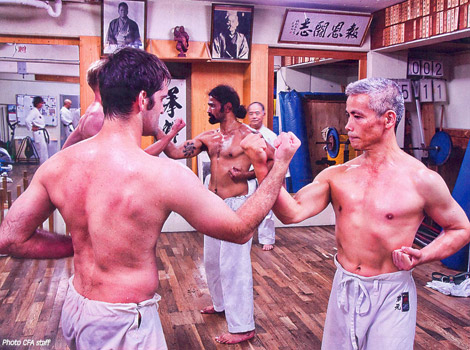
Body conditioning, in this case the repeated striking of one's arms against those of an opponent, is an essential element of karate training.
Tetsu geta or iron clogs (iron flip-flops) are used to develop kicking techniques and to strengthen the hip joints, legs, and toes.
The tetsu geta are gripped securely with the toes. While wearing the tetsu geta the karate-ka should perform knee kicks, heel kicks, and leg swings as fast and as high as possible. The tetsu geta should then be removed and the legs swings repeated as rapidly and powerfully and as high as you can manage. This will develop flexibility, strength in the associated areas, and a truly fast and powerful kick.
The basic kick may then be performed in slow motion as high as you can to develop balance and a strong, clean technique. It is recommended that any kick in which you snap the knee only be performed in slow motion while wearing the tetsu geta. A fast snapping action with this weight on the foot can cause serious damage to the knee.
Although the kicks should be practiced as high as possible while practicing with tetsu geta, all kicks are low in Goju Ryu kata. The reason for practicing high kicks is to develop flexibility and strength, which then improves the lower kicks in kata. Under no circumstances should the kata's kicking target be changed.
The makiwara or punching board has many forms, but only one will be discussed in this article, the stationary traditional makiwara. This type of makiwara is a piece of wood set vertically into the ground so that the top of the wood is about shoulder height. Its width shouldn't be much more than that of a fist. The striking surface of the makiwara shouid be wrapped in straw (this is the literal meaning of makiwara) and may be covered in leather.
There is an unlimited number of ways to strike the makiwara, but this article will only discuss the most basic form, the gyaku suki (reverse punch). While standing in zen kutsu datchi strike the head of the makiwara with the same hand as the back leg (gyaku suki), concentrating on the first two knuckles (the knuckles of the index and middle fingers) of the fist. These should be the only knuckles making contact with the makiwara. When punching, the body shouid twist like a propeller, the head and torso being the hub and the arms the blades. As one arm pulls back to high chamber, the body rotates and the opposite hand strikes the makiwara. As the hand strikes, the back leg shouid straighten and push that hip behind the punch, drawing power from the floor. It is very important to have a good stance with the feet firmly planted on the ground, as this is what gives you a powerful punch. Through repetition this will become natural.
Makiwara practice is essential for perfecting a strong punch. It will accustom the body to impact, develop power rooted to the ground, and condition the knuckle and other bones in the hands and wrist.
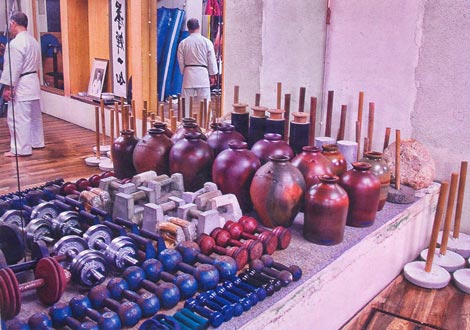
The Goju Ryu "toolbox".
This photograph, taken at the Higaonna Dojo in Tsuboya, Okinawa, demonstrates the importance that senior Goju Ryu practitioners place in body conditioning and strengthening. This is a vital part of the legacy of Chojun Miyagi, and something that shouid be part of every karateka's training regime.
AII hojo undo shouid be practiced often in conjunction with Sanchin Kata. Without hojo undo practice it is very difficult to obtain the required strength to perform Goju Ryu kata applications, and most likely the karate-ka's Sanchin Kata will remain weak. Hojo Undo is a key element of Goju Ryu karate and must never be neglected by the serious practitioner.
Classical Fighting Arts magazine
www.classicalfightingarts.org
